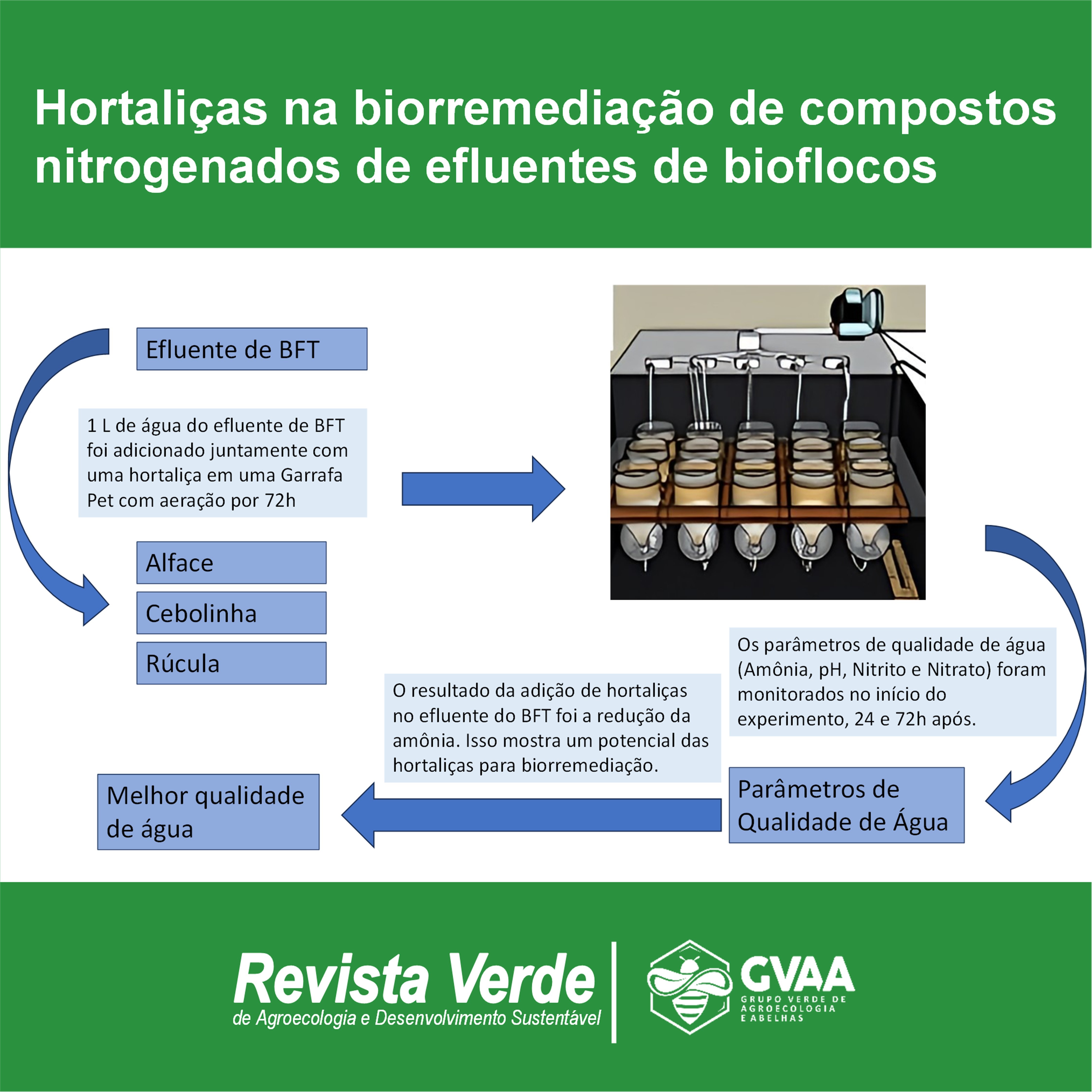Vegetables in the bioremediation of nitrogen compounds from biofloc effluents
DOI:
https://doi.org/10.18378/rvads.v19i1.9832Keywords:
Ammonia, Aquaculture, Nitrite, Nitrate, NitrificationAbstract
Our work aims to evaluate the changes in the water quality parameters of the effluent of a biofloc system (BFT) after the insertion of vegetables. Vegetable seedlings of three species were used: lettuce (Lactuca sativa), arugula (Eruca sativa), and green onion (Allium schoenoprasum). Twelve polyethylene terephthalate bottles were used, divided into four groups (three different vegetables and control), in triplicate, equipped with an aeration system (individually) to avoid BFT sedimentation. The bottles were kept in a polyethylene box (180L). The bottles were filled with 1 L of BFT water used as the initial sample (zero time). The pH, total ammonia, nitrite and nitrate were measured at time zero, 24 hours and 72 hours after the insertion of the different vegetables in the experimental system. It was possible to observe improvements in the ammonia levels 24 h after the insertion of vegetables, as the treatments (Lettuce, Chives and Arugula) reduced the amount of ammonia when compared to the control group. However, there was little influence on pH, nitrite and nitrate. Therefore, we can conclude that the insertion of vegetables in the effluent reduces ammonia levels, improving water quality parameters and, therefore, can reduce the environmental impact or act as bioremediators of the cultivation environment.
Downloads
References
BOYD, C. E. Water quality: an introduction. Springer Nature, 2019.
EMERENCIANO, M.; GAXIOLA, G.; CUZON, G. Biofloc technology (BFT): a review for aquaculture application and animal food industry. Biomass Now-Cultivation and Utilization. Miodrag Darko Matovi Intech Open. InTech, Croatia, 2013. DOI: https://doi.org/10.5772/53902
EMERENCIANO, M.; MARTÍNEZ-CÓRDOVA, L. R.; MARTÍNEZ-PORCHAS, M.; MIRANDA-BAEZA, A. Biofloc technology (BFT): a tool for water quality management in aquaculture. In: Tutu H, editor. Water Quality. London (UK). 10.5772/66416
ESTRADA‐PEREZ, N.; HERNANDEZ-LLAMAS, A.; RUIZ-VELAZCO, J. M. J.; ZAVALA-LEAL, I.; ROMERO-BAÑUELOS, C. A.; CRUZ-CRESPO, E.; JUÁREZ-ROSSETE, C.; DOMÍNGUEZ-OJEDA, D.; CAMPOS-MENDOZA, A. Stochastic modelling of aquaponic production of tilapia (Oreochromis niloticus) with lettuce (Lactuca sativa) and cucumber (Cucumis sativus). Aquaculture Research, v. 49, n. 12, p. 3723-3734, 2018. 10.1111/are.13840 DOI: https://doi.org/10.1111/are.13840
ENDUT, A.; JUSOH, A.; ALI, N. A.; WAN NIK, W. B. Nutrient removal from aquaculture wastewater by vegetable production in aquaponics recirculation system. Desalination and water treatment, v. 32, n. 1-3, p. 422-430, 2011. 10.5004/dwt.2011.2761 DOI: https://doi.org/10.5004/dwt.2011.2761
FINK, M.; FELLER, C. An empirical model for describing growth and nitrogen uptake of white cabbage (Brassica oleracea var. capitata). Scientia horticulturae, v. 73, n. 2-3, p. 75-88, 1998. 10.1016/S0304-4238(97)00154-4 DOI: https://doi.org/10.1016/S0304-4238(97)00154-4
HU, Z.; LEE, J. W.; CHANDRAN, K.; KIM, S.; BROTTO, A. C.; KHANAL, S. K. Effect of plant species on nitrogen recovery in aquaponics. Bioresource technology, v. 188, p. 92-98, 2015. 10.1016/j.biortech.2015.01.013 DOI: https://doi.org/10.1016/j.biortech.2015.01.013
JATOBÁ. A.; BORGES, Y.V.; SILVA, F.A. BIOFLOC: sustainable alternative for water use in fishculture. Arquivo Brasileiro de Medicina Veterinária e Zootecnia, 71, 3, 1076-1080, 2019. 10.1590/1678-4162-10309 DOI: https://doi.org/10.1590/1678-4162-10309
JATOBÁ, A.; STOCKHAUSEN, L.; SILVA, L. R.; ANDRADE, J. I. A. Therapeutic bath of mint hydrolate in the control of monogenea for four tilapia species. Boletim do Instituto de Pesca, v. 49, 2023. 10.20950/1678-2305/bip.2023.49.e706 DOI: https://doi.org/10.20950/1678-2305/bip.2023.49.e706
KOTZEN, B.; EMERENCIANO, M.; MOHEIMANI, N.; BURNELL, G. M. Aquaponics: Alternative types and approaches. Aquaponics food production systems: Combined aquaculture and hydroponic production technologies for the future, p. 301-330, 2019. 10.1007/978-3-030-15943-6_12 DOI: https://doi.org/10.1007/978-3-030-15943-6_12
MARTINEZ-CORDOVA, L. R.; LÓPEZ-ELÍAS, J.; MARTINEZ-PORCHAS, M.; BRINGAS-BURGOS, B.; NARANJO-PARAMO, J. A preliminary evaluation of an integrated aquaculture-agriculture systems (tilapia and peppers) at mesocosm scale. J Aquac Mar Biol, v. 9, n. 1, p. 19-22, 2020. 10.15406/jamb.2020.09.00272 DOI: https://doi.org/10.15406/jamb.2020.09.00272
OLSSON, M. O.; FALKENGREN, U. G. Potential nitrification as an indicator of preferential uptake of ammonium or nitrate by plants in an oak woodland understorey. Annals of Botany, v. 85, n. 3, p. 299-305, 2000. 10.1006/anbo.1999.1075 DOI: https://doi.org/10.1006/anbo.1999.1075
PINHO, S. M.; DE LIMA, J. P.; TARIGAN, N. B.; DAVID, L. H.; PORTELLA, M. C.; KEESMAN, K. J. Modelling FLOCponics systems: Towards improved water and nitrogen use efficiency in biofloc-based fish culture. Biosystems Engineering, v. 229, p. 96-115, 2023. 10.1016/j.biosystemseng.2023.03.022 DOI: https://doi.org/10.1016/j.biosystemseng.2023.03.022
READ, P.; FERNANDES, T. Management of environmental impacts of marine aquaculture in Europe. Aquaculture, v. 226, n. 1-4, p. 139-163, 2003. 10.1016/S0044-8486(03)00474-5 DOI: https://doi.org/10.1016/S0044-8486(03)00474-5
SUMITRO, T. B.; FAUZI, H.; EKASARI, J. Production performance and nitrogen and phosphorus mass balance in biofloc-based African catfish intensive culture at different densities. Jurnal Akuakultur Indonesia, v. 20, n. 1, p. 82-92, 2021. 10.19027/jai.20.1.82-92 DOI: https://doi.org/10.19027/jai.20.1.82-92
VINATEA-ARANA, L. Princípios químicos de qualidade da água em aqüicultura. Florianópolis: Editora da UFSC, 1997.
WU, Y.; DUAN, Y.; WEI, Y.; AN, D.; LIU, J. Application of intelligent and unmanned equipment in aquaculture: A review. Computers and Electronics in Agriculture, v. 199, p. 107201, 2022. 10.1016/j.compag.2022.107201 DOI: https://doi.org/10.1016/j.compag.2022.107201
ZHOU, X.; WANG, J.; HUANG, L.; LI, D.; DUAN, Q. Modelling and controlling dissolved oxygen in recirculating aquaculture systems based on mechanism analysis and an adaptive PID controller. Computers and Electronics in Agriculture, v. 192, p. 106583, 2022. 10.1016/j.compag.2021.106583 DOI: https://doi.org/10.1016/j.compag.2021.106583

Downloads
Published
How to Cite
Issue
Section
License
Copyright (c) 2023 Samantha Heiderscheidt et al.

This work is licensed under a Creative Commons Attribution 4.0 International License.










